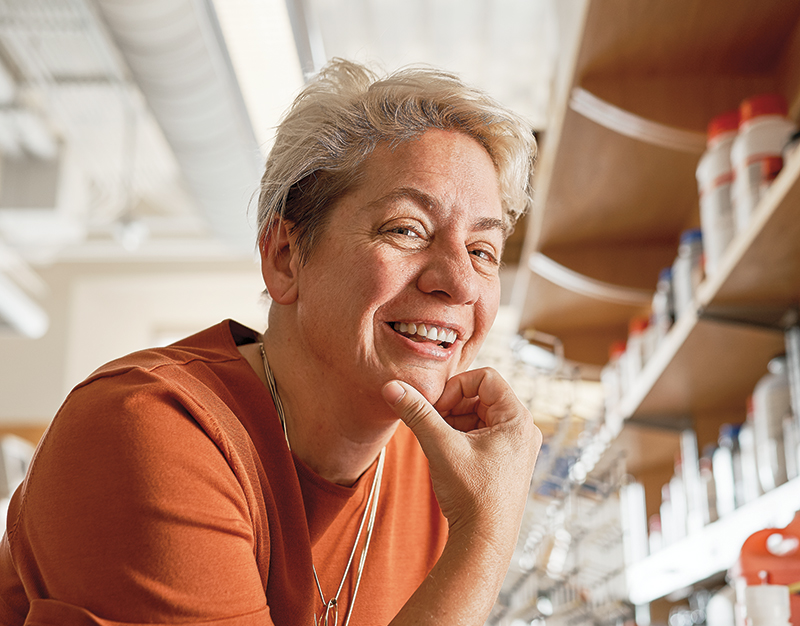
In the beginning, there was light. And, for Sandy Rosenthal ’87, Ph.D., it’s light that ties the common threads of her life experiences together. In Thy Light We See Light. Valpo students and alumni know this motto well. After earning a degree in chemistry at Valpo, Sandy earned her doctorate at the University of Chicago.
A life-changing episode occurred six weeks after Sandy defended her thesis in 1993. The onset was sudden and unexpected, but it would be five years before Sandy had a diagnosis of bipolar disorder, and two more years before she was able to find the right mix of medication to help her manage the symptoms, which are tied to daylight.
“Seasonal bipolar means I’m up in the spring and down in the fall. I’ve learned to live with it,” Sandy says. “My experience goes exactly with the earth’s orbit around the sun and is related to how many hours of daylight occur. It is set in stone so I can plan for it in mood and energy and know it will reflect the change in daylight hours.”
Currently, Sandy serves as the Jack and Pamela Egan Professor of Chemistry at Vanderbilt University, and she is the former director of the Vanderbilt Institute for Nanoscale Science and Engineering. She says she didn’t plan to have her teaching and research focus on light, but that is exactly what happened. Sandy’s work with white-light emitting nanocrystals, or quantum dots, has earned her awards and garnered millions of dollars in research funding.
It was partly by happenstance that her research has led to applications in new lighting elements. When she came to Vanderbilt, she had no idea the direction her research would take. Equally devoted to teaching as to her research, Sandy says that’s why Vanderbilt is an ideal fit.
As an undergraduate at Valpo, Sandy says she was already learning graduate-level concepts because of the exemplary chemistry faculty like Professor Gil Cook, Ph.D. and the texts he used in the classroom. “She always wanted to know more than the superficial, and she was very diligient in her studies. It impressed me that she played basketball and never let her studies slip,” Professor Cook says.
Sandy also remembers the lack of daylight in the labs.
“I’m envious of the space where today’s students get to do their chemistry research in the Center for the Sciences,” Sandy says. “I loved Neils, but the types of chemistry able to be studied in the new facility are going to generate a whole new class of chemistry professionals who make an impact in the world. Form dictates function.”
One of Sandy’s accomplishments at Vanderbilt was creating a space to study and use materials on a nano scale when you cannot have dust around. “A speck of dust at the nano scale is like Mt. Everest landing on a car,” she says.
At Valpo Sandy says she learned to see the connections between disciplines and meaning in her studies, and that is still evident today. Some of this research can make an impact on neuroscience.
“We can use larger quantum dots that emit colored light and link them to proteins that regulate neurotransmitters. Since we can light up the proteins we can make movies of their movements with a fluorescence microscope,” Sandy says. “Ultimately I want to understand how changes in daylight affect molecular mechanisms of mental disorders.”
When she wasn’t busy with friends or in the basement of Neils, Sandy was on the basketball court. She spent four years as a Valpo athlete on the women’s basketball team, and she compares her experiences living with bipolar disorder as having the endurance and mindset of an athlete.
“My background as an athlete taught me resilience, and it’s been key to me thriving while living with bipolar,” Sandy says. “I learned to push myself, and that perseverance was key to developing my research and earning tenure at a research university.”
Something as simple as the light of day has had a profound impact on Sandy’s life and career, and a foundation in science and chemistry have become the focus of her research and teaching. A similar experience—whether for Sandy’s students at Vanderbilt or those beginning their studies in Valpo’s Center for the Sciences—will continue to blaze new pathways of understanding. The light will lead them in myriad directions to improve the lives of others…and perhaps themselves.
